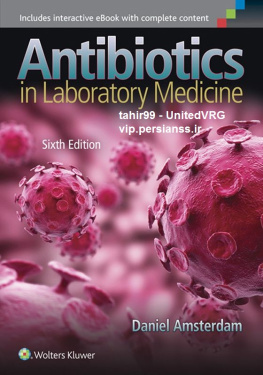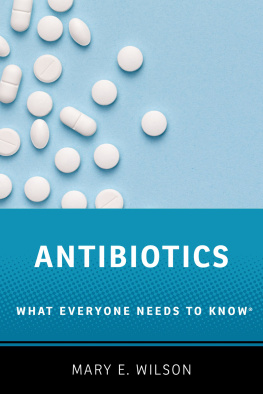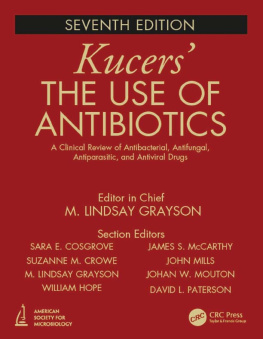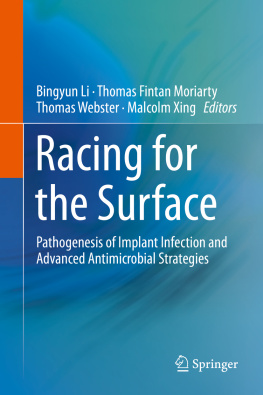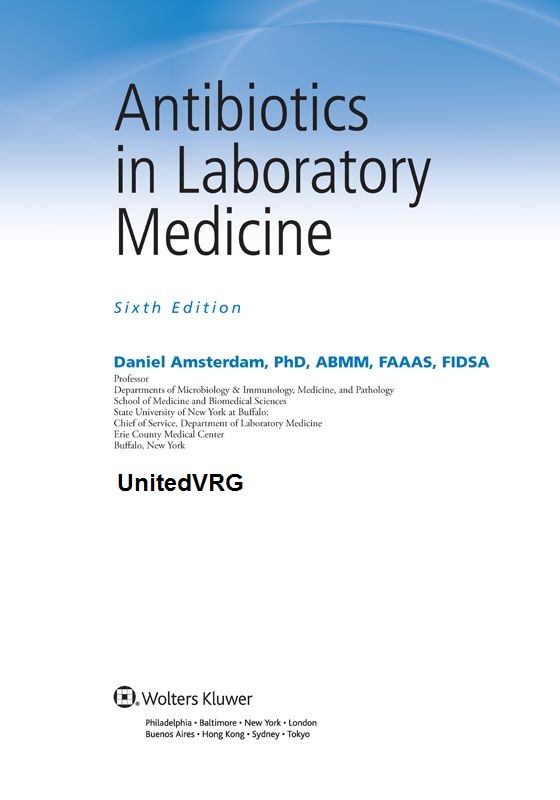Antibiotics
in Laboratory
Medicine Sixth Edition |
Acquisitions Editor: Julie Goolsby
Product Development Editors: Kristina Oberle and Andrea Vosburgh
Production Project Manager: Joan Sinclair
Design Coordinator: Terry Mallon
Manufacturing Coordinator: Beth Welsh
Prepress Vendor: Absolute Service, Inc.
6th edition
Copyright 2015 Wolters Kluwer
Copyright 2005 Wolters Kluwer Health / Lippincott Williams & Wilkins. Copyright 1996, 1991, 1986, 1980 by Williams & Wilkins. All rights reserved. This book is protected by copyright. No part of this book may be reproduced or transmitted in any form or by any means, including as photocopies or scanned-in or other electronic copies, or utilized by any information storage and retrieval system without written permission from the copyright owner, except for brief quotations embodied in critical articles and reviews. Materials appearing in this book prepared by individuals as part of their official duties as U.S. government employees are not covered by the above-mentioned copyright. To request permission, please contact Wolters Kluwer Health at Two Commerce Square, 2001 Market Street, Philadelphia, PA 19103, via email at (products and services).
9 8 7 6 5 4 3 2 1
Printed in China.
Library of Congress Cataloging-in-Publication Data
Antibiotics in laboratory medicine / [edited by] Daniel Amsterdam. Sixth edition.
p. ; cm.
Includes bibliographical references and index.
ISBN 978-1-4511-7675-9 (alk. paper)
I. Amsterdam, Daniel, editor.
[DNLM: 1. Microbial Sensitivity Tests. 2. Anti-Bacterial Agentspharmacology. 3. Drug Resistance, Microbialphysiology. QW 25.5.M6]
QR69.A57
615.329dc23
2014022704
Care has been taken to confirm the accuracy of the information presented and to describe generally accepted practices. However, the authors, editors, and publisher are not responsible for errors or omissions or for any consequences from application of the information in this book and make no warranty, expressed or implied, with respect to the currency, completeness, or accuracy of the contents of the publication. Application of this information in a particular situation remains the professional responsibility of the practitioner; the clinical treatments described and recommended may not be considered absolute and universal recommendations.
The authors, editors, and publisher have exerted every effort to ensure that drug selection and dosage set forth in this text are in accordance with the current recommendations and practice at the time of publication. However, in view of ongoing research, changes in government regulations, and the constant flow of information relating to drug therapy and drug reactions, the reader is urged to check the package insert for each drug for any change in indications and dosage and for added warnings and precautions. This is particularly important when the recommended agent is a new or infrequently employed drug.
Some drugs and medical devices presented in this publication have Food and Drug Administration (FDA) clearance for limited use in restricted research settings. It is the responsibility of the health care provider to ascertain the FDA status of each drug or device planned for use in his or her clinical practice.
LWW.com
For Victor Lorian, MD (deceased), my mentors and coauthors in this and other works, and as always, for my steadfast wife, Carol, and my children, Jonathan and Valerie.
As a former contributor to Antibiotics in Laboratory Medicine , I am pleased and honored to take on the editorial leadership of the sixth edition to carry on the vision of the founding editor, Victor Lorian, MD. Dr. Lorians editorial direction spanned more than 30 years and this acknowledgment is a small tribute to his role. In the nascent edition, there were only antibacterial agents deliberated. Succeeding editions witnessed the expanding role of antifungal and antiviral compounds.
In addition to Dr. Lorians vital contribution, this edition acknowledges the efforts of chapter authors from previous editions who were unable to continue in this work.
Since their discovery and introduction into the armamentarium of medicines, antibiotics have saved countless lives and contributed to the rapid advancement of modern medicine. The legacy drugs, penicillin, tetracycline, and their contemporary successors have been essential in sustaining health and dealing with human diseases. Their use to treat infections should be considered a global health resource that needs to be carefully conserved. Yet, we are confronted by the expanding scope of drug resistance and more pointedly multidrug resistance, which highlights the reliance on laboratory antimicrobial susceptibility and resistant gene testing. It has become patently clear that for many organisms once considered reliably susceptible to a number of broad-spectrum agents, unexpected resistance can occur as a result of foreign travel or multidrug courses of therapy during a hospital admission.
In recent editions of Antibiotics in Laboratory Medicine , which have now has spanned more than 35 years, nearly half the antibiotic era, readers have witnessed the role of newer compounds and drug classes including antifungal and antiviral agents, albeit limited the past decade, and had access to methods and approaches for determining efficacy and detailing the mechanisms of action and resistance of these compounds in vivo and in vitro.
New for this edition are the introductory Perspectives and the Appendix. The former deals with the outlook of antiinfective compounds; their origin and archeologic niche in nature; and their current role, development, and future application. In the Appendix are the Web addresses that readers can select for learning more about the nature of the drugs, current resistance patterns and trends, and their clinical application. Each of the intervening chapters, by new or former author(s) expanded and reworked, represent current science and laboratory practice. Several aspects of this volume are worth highlighting. In , Dr. Bamberger and colleagues have used their vast clinical experience and knowledge and document the distribution of antimicrobial agents in extravascular compartments.
As a former (and current) contributor, I am cognizant of and in awe of my fellow authors who participated in this work and made this edition of Antibiotics in Laboratory Medicine scientifically sound and clinically meaningful. The sixth edition is authored by an international group of distinguished scientists and physicians, expert in their discipline, brilliant in their vision, and recognized worldwide.
Daniel Amsterdam
Paul G. Ambrose, PharmD
Associate Research Professor
Pharmacy Practice
School of Pharmacy and Pharmaceutical Services
University at Buffalo
Amherst, New York
Daniel Amsterdam, PhD, ABMM, FAAAS, FIDSA
Professor
Departments of Microbiology & Immunology, Medicine, and Pathology
School of Medicine and Biomedical Sciences
State University of New York at Buffalo;
Chief of Service, Department of Laboratory Medicine
Erie County Medical Center
Buffalo, New York
David R. Andes, MD
Professor
Departments of Medicine and Microbiology
Chief, Division of Infectious Diseases
University of Wisconsin
Madison, Wisconsin

